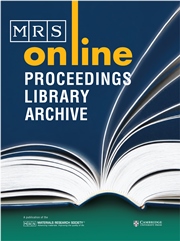No CrossRef data available.
Article contents
High Temperature Clay Filled Epoxy Composites
Published online by Cambridge University Press: 26 February 2011
Abstract
The primary objective of this study is to improve the thermal stability ofclay and clay filled composite. An epoxy-clay composite has been prepared bydispersing 1-hexadecyl-3-(6-hydroxyhexyl)-2-methylimidazolium modified clayin an epoxy resin and cured with metaphenylene diamine(m-PDA) at 110.0 °C for 7 h and post cured at 140°C for 4h. The thermal stability of the modified clay and clay filled epoxycomposite was characterized via thermogravimetric analysis (TGA). The onsetdecomposition temperature of the imidazolium functionalized clay was 360°C.Transmission Electron Microscopy (TEM) of the composite showed mixedmorphology with predominant fraction of intercalated clay platelets in theepoxy matrix. The onset decomposition temperature of the modified clayfilled epoxy composite was found to be higher than that of pristineepoxy.
Information
- Type
- Research Article
- Information
- Copyright
- Copyright © Materials Research Society 2007

